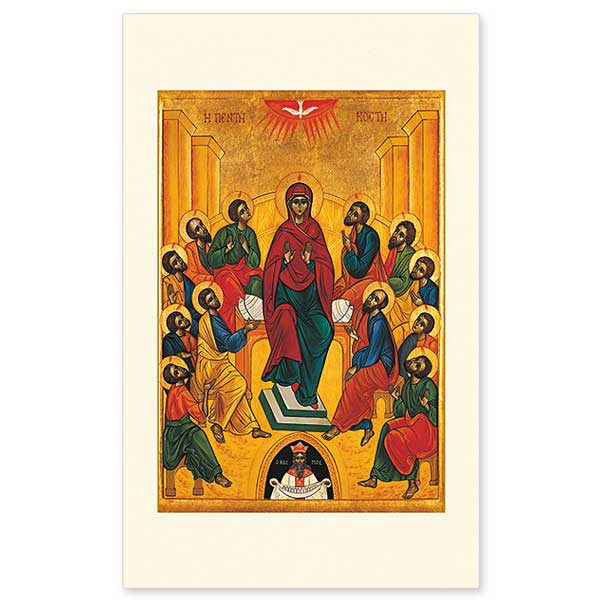

| Cards as shown (No Imprinting) | |||||
| Item Number | Description | Price Each | Quantity | Total | Action |
|---|---|---|---|---|---|
| PCM504 | Package of 25 icon holy cards |
$8.50 |
package |
$8.50 | |
| Item Number | Select Imprinting option: | Price Each | Quantity | Total | Action |
|---|---|---|---|---|---|
| Not Selected |
|
|
cards 30 piece minimum. |
The feast of Pentecost signals the end of the Easter season and commemorates the great event described in Acts 2:1-4. This early Byzantine design shows Mary and the Twelve receiving the gift of the Holy Spirit, coming in “tongues, as of fire."
Icon holy cards are 3" x 5", a convenient size for use as gifts or bookmarks. The backs are blank except for a faint colophon at the bottom, leaving plenty of room for custom imprinting with your own message.
Pentecost is derived from the Greek word for fifty. Pentecost, also known as Shav’uot or the Festival of Weeks, is one of the three major festivals of the Jewish year and dates from ancient times. See, for example, Old Testament references in Exodus 34:22, Leviticus 23:4-21, and Chronicles 8:13. The festival of Passover, commemorating the liberation from slavery in Egypt, is a week-long observance, ending on a Saturday, the Jewish Sabbath. As prescribed in Leviticus 23, the day after the Passover Sabbath is the Feast of First Fruits, celebrating the beginning of grain harvest. Then, fifty days later is the Festival of Weeks, at which an offering from the harvest is offered commemorating the giving of the Torah (the first five books of the Old Testament) to the Jews. Christians believe that Jesus fulfilled these ancient feasts in a new and very striking way. Christ was crucified on Friday of Passover week, the Pascal Lamb offered up as sacrifice for our sins. On the following Sunday, He arose from the dead on the Feast of First Fruits, hence St. Paul’s words in I Corinthians 15:20. Then, fifty days later on Pentecost, the Holy Spirit came to the Apostles; the beginning of the Christian Church on the very day that commemorated the beginning of Judaism.
The pattern for this icon is very old, conforming to Byzantine traditions dating from before 800 AD. Mary and the Apostles are touched by "tongues, as of fire" as the Holy Spirit shown as a dove accompanied by fire descends upon them, transforming a group of frightened people into bold proclaimers of the Good News. See Acts, Chapter 2.
The Apostles are shown gazing heavenward in poses of surprise and apprehension. Tradition does not name all of their portraits explicitly. Naming them yourself is an interesting meditation. They all have halos of gold surrounding their heads. Halos are used in iconography to identify saints. Gold, being a metal that doesn’t corrode, is used to symbolize Divine light.
Mary is shown in her traditional garb of a dark red homophorion (a combination veil and cape) over a blue dress. Three stars grace her homophorion that symbolize her virginity, before, during, and after Jesus’ birth. She gazes toward the viewer with hands raised in prayer, her dignified manner in sharp contrast with that of the twelve Apostles.
Below Mary is a man with a long beard, crowned head, and bearing a cloth holding twelve scrolls. The Greek letters identify him as Cosmos, "the world." He is a symbolic representative of the world’s multitudes gathered together in Jerusalem for the Festival of Weeks at the time of that first descent of the Holy Spirit. He is in a walled-off dark place, the world without faith. His crown is the rule of sin and he is aged by the sin of Adam. The scrolls represent the teaching of the Twelve Apostles, bringing the light of faith to his dark world.